The Best Deals on Camping, Backpacking and Outdoor Gear [June 2025]
You know I love a good daypack. Bonus points if it also looks as good as it is functional. Fortunately, the newly updated Loris 25 daypack from Gossamer Gear, which is more sustainable than ever thanks to a recent materials upgrade, is just that.
Is it the perfect daypack? Well, I dunno about that. But it might be pretty dang close. And who am I to say whether or not it’s perfect for you? After all, that’s why we do all these reviews; to show you high quality, sustainable gear, highlight what’s great about it–or not–to help you figure out if it’s the right pack for YOU. That way you don’t have to buy a bunch of gear and waste money AND resources in your pursuit of the perfect pack.
But let’s get into it, already. Starting with the functions and features that make this backpack unique and how to performed in the real world.
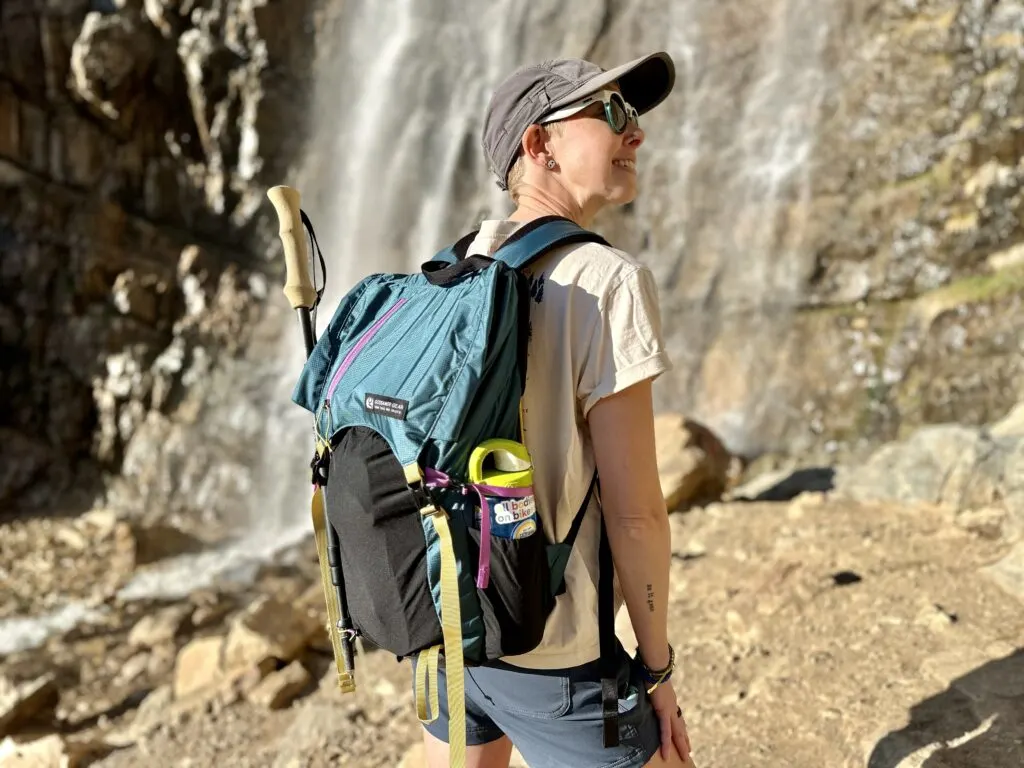
Gossamer Gear Loris 25: The Features
Features make the daypack. At least in our opinion. Here’s some of what this daypack boasts in that department:
- 25L capacity
- Large stretchy mesh stash pocket on the front
- Two secure zipper pockets (one on the lid, another inside)
- Dual stretchy water bottle side pockets
- Trekking pole bungee for lashing poles on the outside
- Removable SitLight Pad that doubles as a frame of sorts
- Hydration or laptop/tablet sleeve inside
- Side compression straps
- Easy-access zipper down the front
- Recycled Robic fabric
- Ultralight: just 19.5 ounces
But how did all those features come together to create a useful, functional pack? Read on to see what we thought of the Loris 25 after testing.
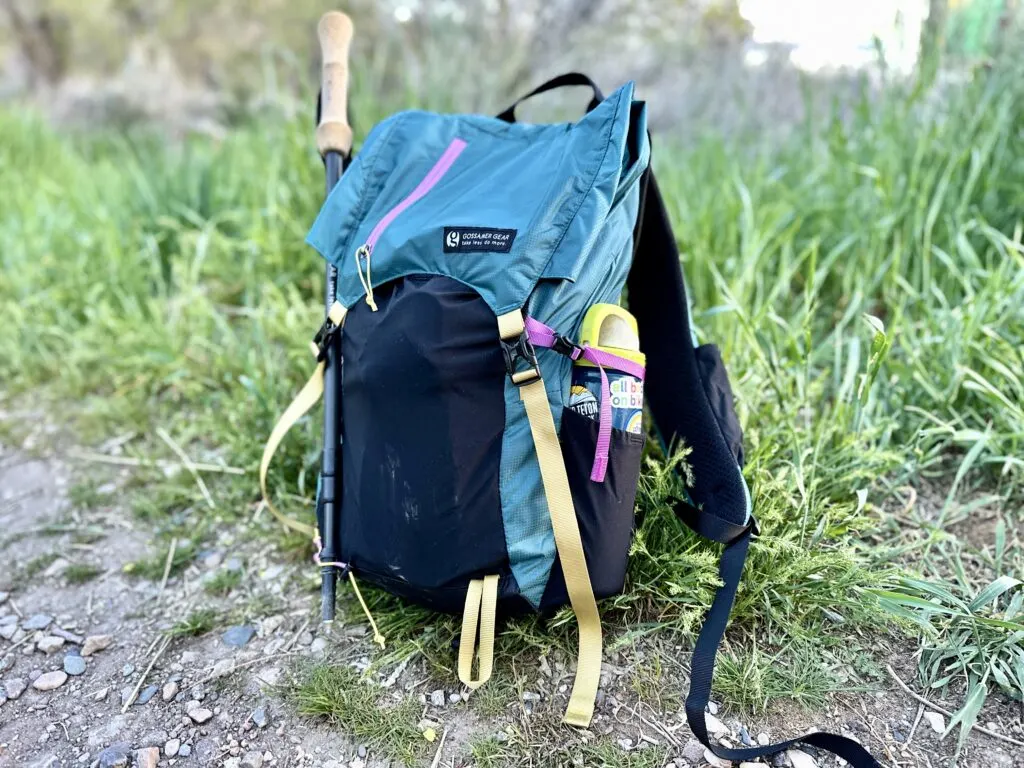
Gossamer Gear Loris 25: The Review
Now, first of all, let me say that this isn’t a brand new design or anything–Gossamer Gear has offered the Loris 25 for a while now–but it did recently get a sustainability upgrade in the way of materials. As of this season, it’s now made with 100% recycled fabrics. And yes, it’s also PFAS-free. That means the carbon footprint of this pack has been reduced by about fifty percent from the original. (That’s a general statistic, not a Loris-specific statistic).
And in case you’ve had other Gossamer bags (like the Gorilla 50 we tested) in the past and you’re wondering if the fabric feels or performs the same….yes. Yes it does. Honestly I cannot tell the difference.
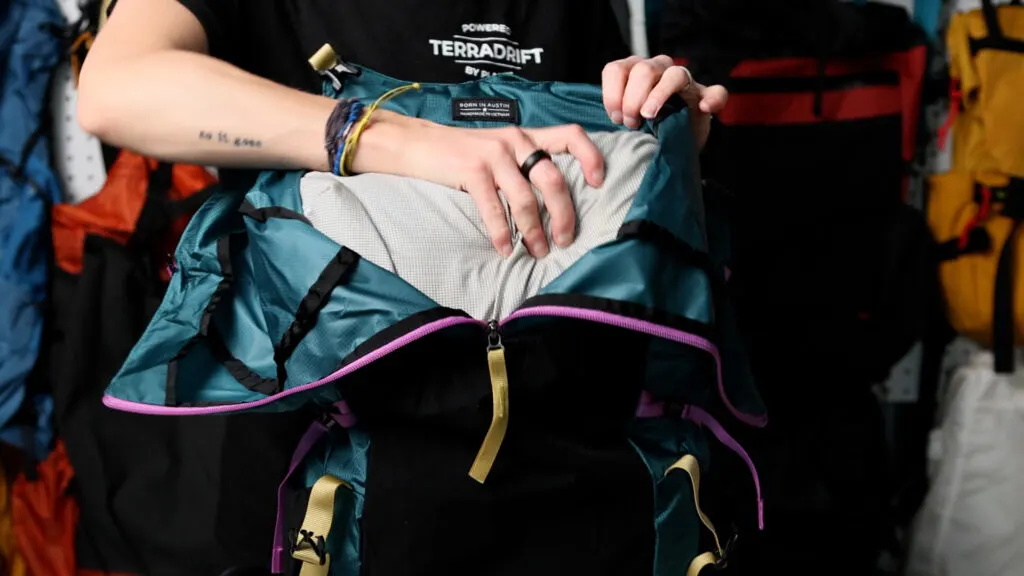
But onto its performance! Starting with the main compartment. ‘Cause why not? It’s a unique one: Instead of a traditional U-shaped zipper on top, the spacious central compartment is accessible by a fold-over, top-down opening coupled with a nice long zipper that runs down the underside of the top flap from the top to the middle front of the bag.
But I have mixed feelings about this opening. On one hand, the mouth with the long zipper offer an easy way to really dig into the bag and find what you’re looking for. Especially if there’s lots of bulky stuff inside.
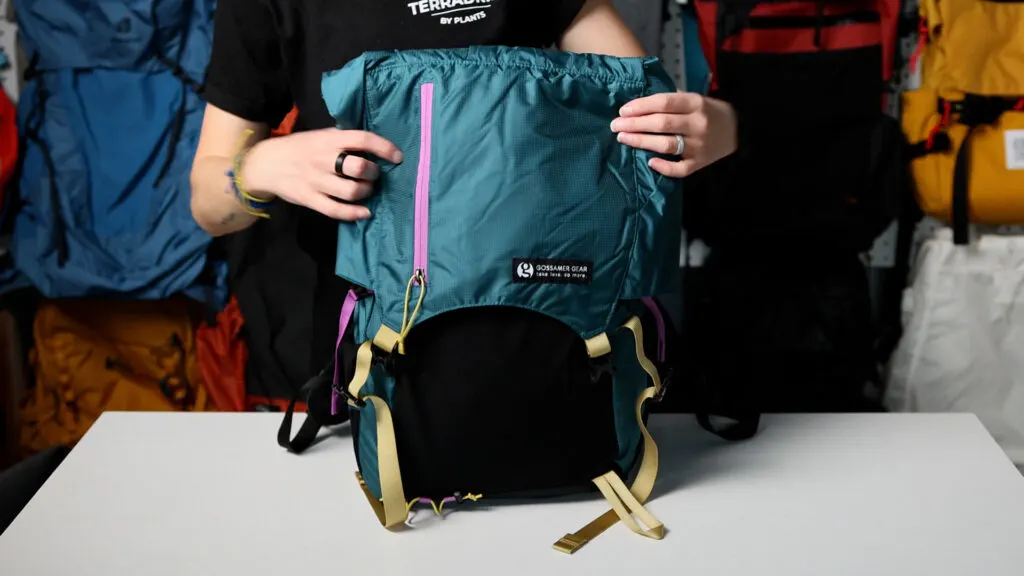
On the other hand, If you are they type of hiker who’s constantly swinging your bag around to grab something out of your bag–be it a rain jacket, sunscreen, snacks, an extra layer, etc., it’s a bit more time consuming to have to undo the two main clips, then the small inner clip meant to keep all the excess material around the mouth nice and compact, and potentially undo the zipper, too, then refasten it all when you’re ready to go again.
I’m that type of hiker, so I found it a bit frustrating having to stop, take my pack off, undo everything, dig around, refasten all the clips, then put the bag back on. It’s not the most highly efficient system, is all. If you tend to just get started and go on most hikes, though, you may not care. And is the top flap a deal breaker? Nah, I don’t think so. Especially when you consider all the other useful features.
Like all the stash pockets. There’s a zipper pocket on the lid, which I’m a big fan of. Love keeping little bits and pieces separate and easy to access. You know, like headphones, hand sanitizer, painkillers, a first aid kit, whatever.
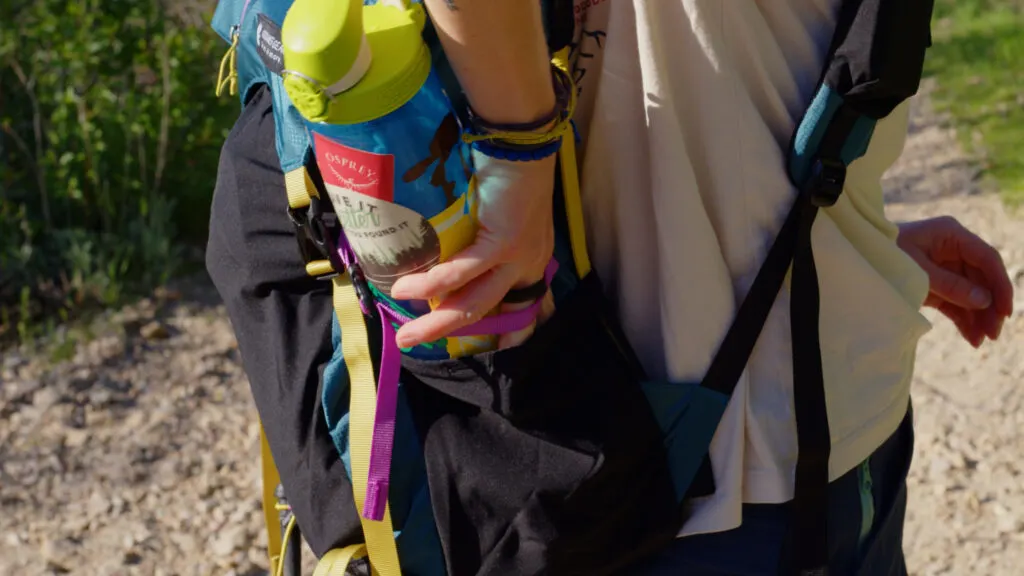
Then there are two side water bottle pockets. A necessity. They were the perfect size and shape to easily slide in my water bottle without taking off my pack. One tip, though: cinch down the compression straps so you know when you’re putting your bottles in the pocket, not just sliding it through the straps.
Then there are two stretchy pockets on the shoulder straps. Which frankly, I’m a big fan of. Now, they are mainly designed to hold Smart Water bottles or some similar hydration device. This is an ultralight pack after all–it’s 19.5 ounces, by the way. And ultralighters are freaking obsessed with their Smart Water bottles.
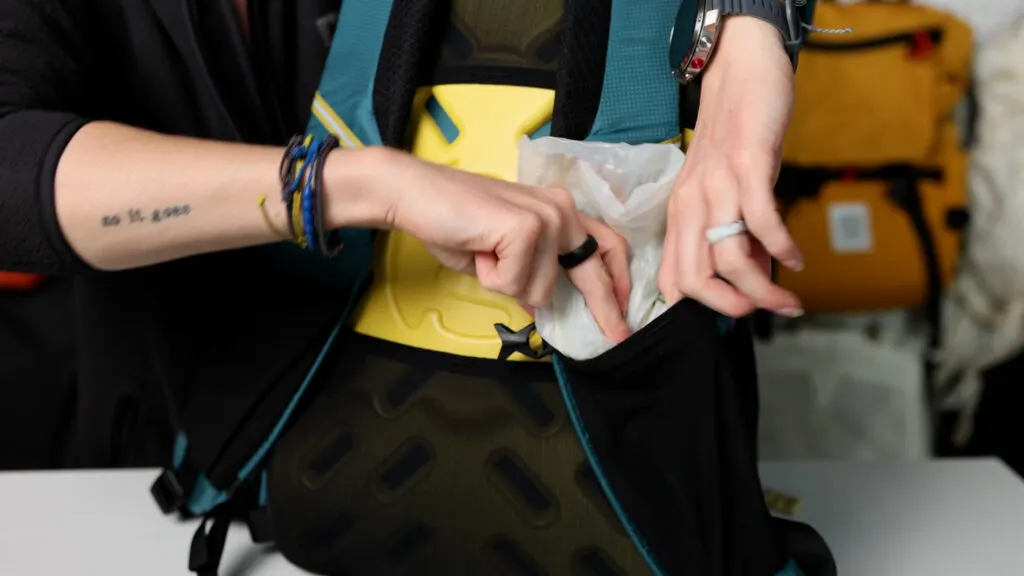
But they are equally good for holding a moderately sized cell phone. My Regular iPhone 14 Pro fits perfectly with a case on, plus I could cram snacks, battery, chargers, or lip balm in the other one. Whatever you want to keep close at hand.
Those shoulder strap pockets are especially handy because the backpack doesn’t come with a hip belt with any pockets. Which is fine because this is an ultralight pack, and you probably won’t be carrying a ton of weight in it anyway, but! If you’re the type who appreciates a hip belt, you CAN purchase an attachable Fast Belt separately from Gossamer gear.
Which I actually really dig, because it makes for a more universally appealing backpack that you can customize to your preferences. Or even to your specific hike. Attach the hip belt if you’ve got the pack loaded with stuff and it’s heavier than usual, or take it off if you’re just going out for a quick hike around the park.
Then there’s the big stretchy front pocket. And I’m a sucker for a big stretchy front pocket. I need to be able to quickly stash a rain jacket, map, charging cables, an extra pair of barefoot sandals… You name it. If a backpack doesn’t have a stretchy front pocket, I don’t want it. Maybe you heard a similar refrain in our Deuter Speed Light CV day pack review.
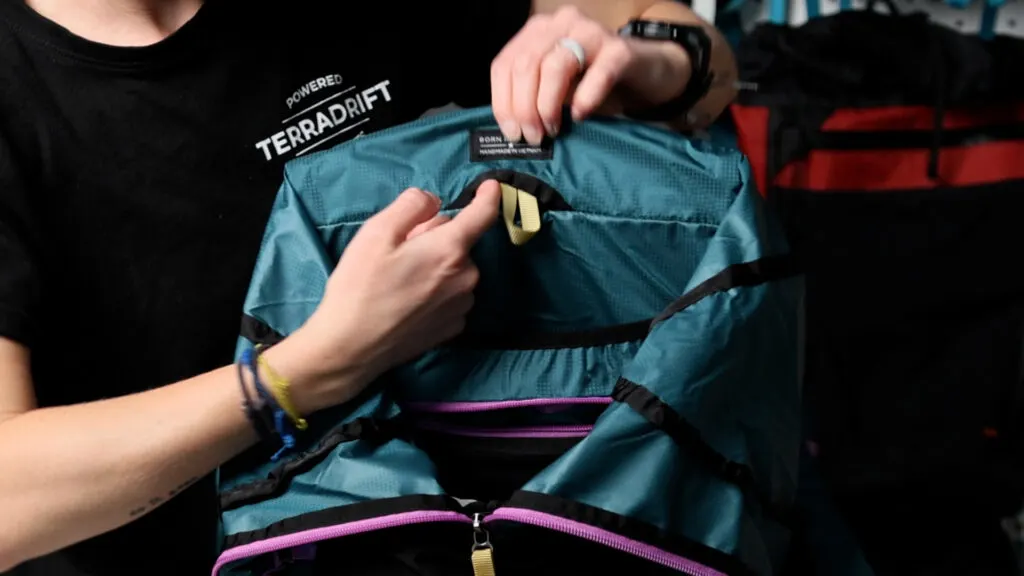
But let’s look inside the bag. There is a hydration reservoir sleeve, which also just as easily functions as a laptop sleeve. My 16 inch MacBook Pro fits perfectly. Meaning this backpack works as a commuter bag in addition to a hiking bag. Meaning you can tackle that 14er or take your laptop to the coffee shop to work on your screenplay. You do you.
There’s also a mesh zippered pocket on the front of the hydration bladder pocket. It’s a nice place to store small loose items that you may not need quick access to but want to keep together anyway.
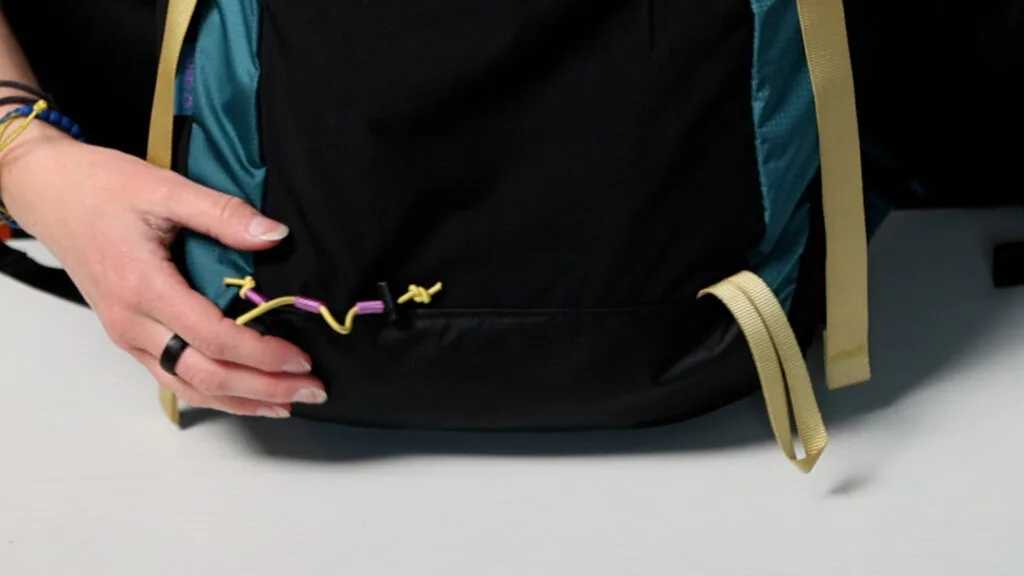
When it comes to stashing gear on the outside, that bag has several attachment points. Clickable compression straps on the side double as security straps for taller water bottles or trekking poles. You just stick the tips of your poles in these little bungee loops at the bottom, tighten as needed, and either clip the compression straps around your pole or place the handles underneath the lid of the bag and secure it closed to hold sticks in place.
There’s an adjustable sternum strap, reflective webbing that doubles as routing for a hydration hose (or you can use it to attach accessories like a camera clip), plus there’s a hydration hose port on top middle of the bag so you can route the hose in either direction.
There’s also an ice ax loop on the bottom and on the back is a brand new removable SitLite pad, which serves multiple purposes: 1.) it creates a frame of sorts and keeps anything hard and angular inside the bag from stabbing you in the back while you hike around all day, 2.) it increases airflow, although you shouldn’t expect the bag to perform as well as say, an Osprey, in that department, and 3.) you can easily pop it out and use the pad as a sit pad during a long hike when you want to either insulate your butt from the cold ground, or just create a more comfortable place to sit. You can also just hike without it if you don’t require the additional structure or lightweight comfort it adds. Or if you wanna shave all of 66 grams from your pack.
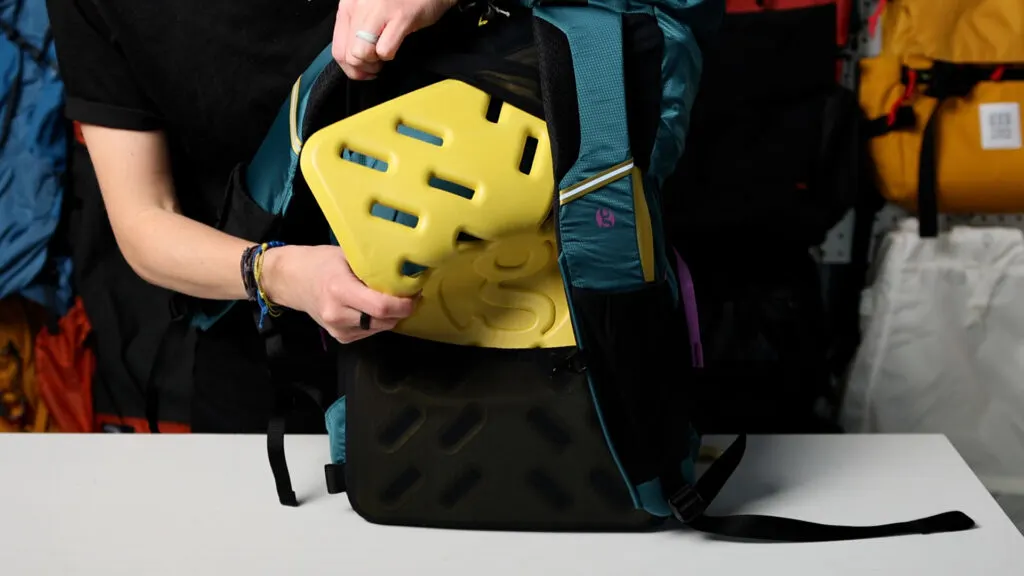
The pad is just made of EVA foam, which isn’t terribly sustainable. It isn’t recyclable or anything. If it gets torn up or damaged, you just have to throw it in the garbage where it’s going to a landfill and will sit for hundreds of years. That said, I do love a good sit pad. Especially on winter hikes when I don’t want to sit directly on the snow. But also on long day hikes when I’d like to take more comfortable breaks every now and then.
And plenty of other daypacks ALSO utilize some sort of foam back panel, so this isn’t me tearing apart the Loris 25. At least this pad offers increased functionality. Just take care of it, OK?
The bag also comes in about four different colors. In case you don’t like this delightfully retro 90s color scheme. I dig it, frankly.
Overall, the pack functioned well on trail. It was comfortable, even without a hit belt, it didn’t move around on my back that much, and I didn’t feel any uncomfortable pressure points.
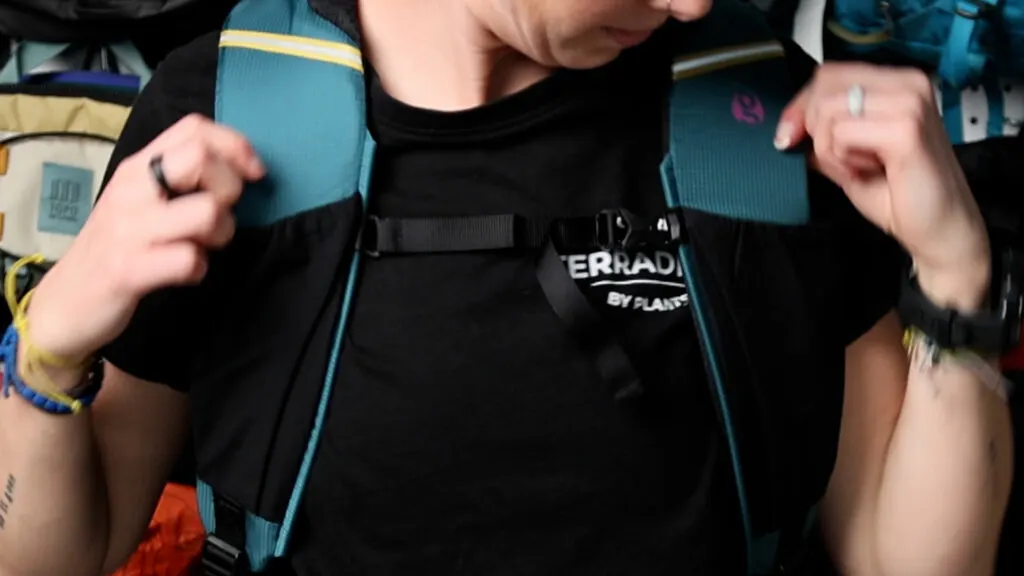
I will say that the shoulder straps are pretty dang wide. Not wide set, which means they didn’t have any trouble staying on my narrow shoulders, but the straps themselves are pretty chunky. I have a fairly small frame, but still, thicker straps don’t necessarily mean more comfortable straps. And if you’re small and have a large chest, the straps likely won’t fit you very comfortably. Hopefully in future iterations, they’ll narrow the straps a bit.
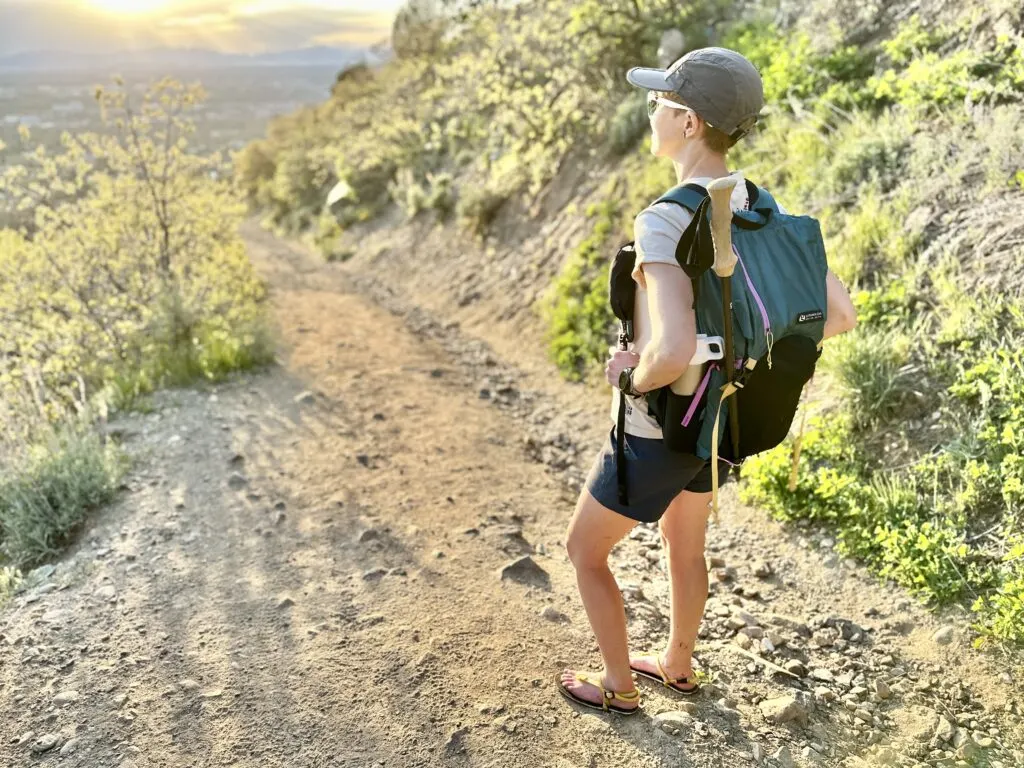
Bottom Line
All in all, this is a feature-rich, functional, useful daypack. It sports most of the things I deem necessary in a daypack (stash pocket, easily accessible water bottle pockets, the ability to hold a laptop, removable sit pad, etc.) and looks pretty dang good doing it. And I do love supporting small brands–Gossamer Gear is based in Austin Texas, by the way.
I’m not the biggest fan of the fold-over style opening–it just doesn’t jive as well with my style of hiking–but that’s me. It may not bother you at all. But it’s a well-made and well-designed pack that’s functional and versatile and feel good giving it a thumbs up. Plus, I dig the colors available and that it’s made out of recycled materials. It’s overall a functional and fun day pack that honestly, should last a pretty long time. (Although it never hurts to keep some patches on hand for when ultralight gear needs a quick repair. Don’t Trash it! Repair it!)
So if you dig the style and are in need of a daypack, this one’s not a bad choice. So shoulder that pack and wander on.
